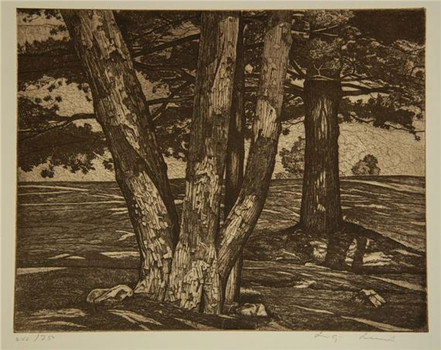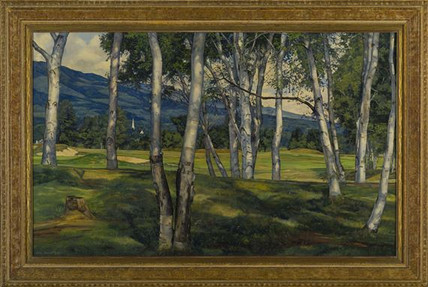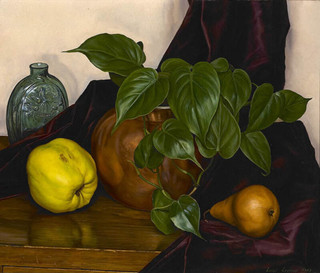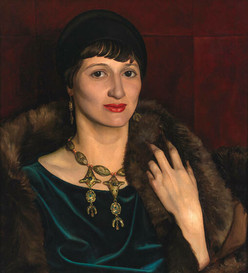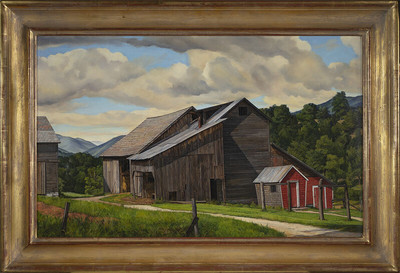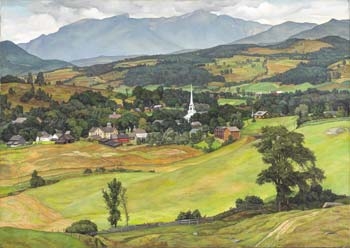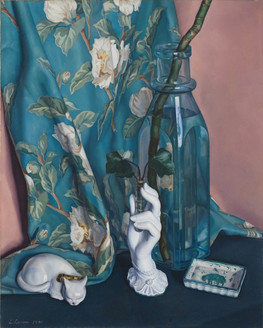
Luigi Lucioni, born 4 November 1900, was an Italian American painter known for his still lifes, landscapes, and portraits.

Lucioni was born in Malnate, Italy, which lies in a mountainous region approximately 30 miles north of Milan, in the foothills of the Alps near the border between Italy and Switzerland. Lucioni's parents, Angelo and Maria Beati Lucioni, who were married in 1890, were from the nearby region of Castiglione Olona, as were Lucioni's grandparents. Lucioni had three older sisters: Angela, Alice, and Aurora. As Lucioni's grandmother was upset by the "pagan" names given to his sisters, his parents named him Giuseppe Luigi Carlo Benevenuto Lucioni, naming him after three saints, in order to make amends with her.
Lucioni, who was greatly influenced by his strict disciplinarian mother, called her "La Bella Beati", or a beautiful blonde woman. His father Angelo was a coppersmith, but was not a good businessman, and often did not follow through by collecting from his customers.
As a child, Lucioni came to adore the natural beauty of the hills and mountainsides when he explored the region between Malnate and the Swiss border, and showed an early interest in art, in particular drawing, possibly influenced by a cousin of his father's, who also harbored a talent for drawing. Lucioni's first classes were in geometrical drawing, and at age six, his talent caught the attention of his teacher, Miss Gadisco, a woman from Varese who had some artistic training herself, and who encouraged him to pursue drawing and etching as a career.
Members of the Lucionis extended family had emigrated to the Transvaal Colony in Africa and to South America, which was a favoured destination of northern Italians at the time, and because of the poor economy of 1900s Italy. Lucioni's father, Angelo emigrated to New York City in 1906, and after establishing himself as a coppersmith and tinsmith, sent for the rest of the family. On 15 July 1911, the family boarded the ship Duke of Genoa for the U.S. Despite traveling steerage, Lucioni recalled the trip as "really nice". The family moved in with Angelo in the apartment he rented on Christopher Street in Manhattan.
Lucioni's mother Maria, who had never lived in a large city, took an immediate dislike to living in New York, and threatened to return to Malnate if the family did not move to a smaller town. On the suggestion of an American that the family had met on the Duke of Genoa, the family moved to North Bergen, New Jersey, and then several more times before settling in 1929 at 403 New York Avenue in Union City, New Jersey.
Lucioni spent four years learning English on the streets of his newly adopted country, and was not placed in first grade until age 11. His life as an American was initially difficult for him, as he endured some bigotry from neighborhood children. He was made to scrub the home's wooden floor on his hands and knees, and not permitted to go out and play until this task was completed, which he credited with instilling in him a sense of discipline that served him well in his artistic life.
Lucioni advanced through his grades and won an academic medal in 1916. After completing the eighth grade, he did not attend school until college. He did take drawing lessons for several years at a drawing school where he worked every night after his studies concluded, copying the plaster heads. He left the school after he refused to acknowledge an instructor's criticism of his perspective.

At age 15, Lucioni entered a competition for admission to Cooper Union and was accepted, taking evening classes while working at a Brooklyn engraving company during the day. The school curriculum was divided into four years, in which he would study geometric shapes, then drawing heads, then antiquities and then finally, drawing from life. For painting, he studied under William de Leftwich Dodge.
As Lucioni recalls it, Dodge was initially not interested in Lucioni's work, and made his feelings known, but was kind and gentle, and allowed Lucioni to visit his studio on West 9th Street, where Lucioni received sound criticism. Lucioni cites Dodge as an influence in his own realisation that one's belief in oneself is the key to fully realise one's own artistic vision, and not the adoption of contemporary trends in art or catering to others' expectations, a theme that Lucioni would express in his career.
At age 19, Lucioni entered New York City's National Academy of Design, where he was introduced to the medium of etching through his instructor in that discipline, William Auerbach-Levy. Lucioni attended school in the morning, and worked in the art department at Fairchild Publications, which published Women's Wear Daily. He continued to take composition classes at Cooper Union.

In 1924 he received a Tiffany Foundation scholarship, which enabled him to spend part of every year for the next decade painting at Tiffany’s Oyster Bay Long Island estate.
Lucioni traveled to Italy in 1925 for the first time since he had left the country as a boy. He later recalled that the Renaissance art that he encountered during the trip “changed my work completely. After seeing the works of Raphael, Botticelli, and Piranesi, I was done for the rest of my life.”
Luigi Lucioni and Paul Cadmus probably met as students, and they doubtless shared acquaintances within New York’s circles of gay artists and writers. Lucioni’s likeness of Cadmus, painted in 1928, celebrated the shared passion of two young moderns for the ideal forms of Italian Renaissance art, particularly the paintings of Piero della Francesca. "Within a modern close-up format, the artist captured a gaze that is at once tentative and mesmerising."

In 1931, he was commissioned to paint a Vermont landscape. While it was not the first time that he had been to the state, he was struck by the beauty of the mountains and their resemblance to northern Italy during the trip, and began visiting regularly. He bought a farmhouse near Manchester in 1939, and from then on divided his time between Vermont and New York City.

While mainly focusing on landscapes, Lucioni also continued to paint portraits of his friends and acquaintances, who were often members of New York’s art and music scene. Bob Elser and his romantic partner, band leader Ted Straetter, were good friends with Lucioni.
In 1938, Lucioni met Ethel Waters through their mutual friend, Carl Van Vechten. After several months, Lucioni asked Waters if he could paint her portrait and she readily agreed so a sitting was arranged at his studio on Washington Square. Waters bought the finished portrait from Lucioni in 1939 for $500. Waters was at the height of her career in 1939, at that time, she was the first African American to have a starring role on Broadway and was already a jazz and blues legend.
"In her portrait, Waters wears a beautifully tailored red dress with an elegant mink coat draped over the back of her chair. Not until one actually views this portrait in person can one feel the human emotion that Lucioni so deftly articulated on canvas. He positioned Waters with her arms tightly wrapped around her waist, a gesture that conveys a sense of vulnerability as if she were trying to protect herself."

In 1969 PBS Vermont paid an on the scene visit with Lucioni in his home in Vermont, in the field as he painted, at the exhibit of his collected paintings at the Shelburne Museum, and at various scenes all around the state of Vermont which the artist has painted.
Luigi Lucioni died July 22 1988, aged 88, in Greenwich Village, New York. Lucioni’s work is in the collections of many leading American museums, including the Metropolitan Museum of Art, Whitney Museum of American Art, Brooklyn Museum, Pennsylvania Academy of the Fine Arts, Dallas Museum of Art, Carnegie Museum of Art, Denver Art Museum, and Nelson-Atkins Museum of Art.

Lucioni's work was marketed through Associated American Artists in New York. Lucioni's portrait of Paul Cadmus was included in the Brooklyn Museum's show "Youth and Beauty: Art of the American Twenties" (winter 2010-2011) and was reproduced for the show's poster.
In 2017, the Huntsville Museum of Art (HMA) acquired the historic Portrait of Ethel Waters. HMA Executive Director, Christopher J. Madkour, and Luigi Lucioni Historian, Dr. Stuart Embury, heard of the painting and were able to track down its whereabouts. The painting was thought to be lost since it had not been viewed by the public since 1942, but the two traced it to a private residence in 2016 and learned the family had plans to auction the painting off in the coming months. The owner graciously allowed the Huntsville Museum of Art to display Portrait of Ethel Waters in the exhibition, American Romantic: The Art of Luigi Lucioni, where it was viewed by the public for the first time in over 70 years. The Museum successfully negotiated the purchase of Portrait of Ethel Waters and it now resides at the Huntsville Museum of Art in Huntsville, Alabama.
Reading Recommendations & Content Considerations
Luigi Lucioni Modern Light








































